The Army Nuclear Power Program (ANPP) was a program of the United States Army to develop small pressurized water and boiling water nuclear power reactors to generate electrical and space-heating energy primarily at remote, relatively inaccessible sites. The ANPP had several accomplishments, but ultimately it was considered to be "a solution in search of a problem." The U.S. Army Engineer Reactors Group managed this program and it was headquartered at Fort Belvoir, Virginia. The program began in 1954 and had effectively terminated by about 1977, with the last class of NPP operators graduating in 1977. Work continued for some time thereafter either for decommissioning of the plants or placing them into SAFSTOR. The current development of small modular reactors has led to a renewed interest in military applications.

The Ignalina Nuclear Power Plant is a decommissioned two-unit RBMK-1500 nuclear power station in Visaginas Municipality, Lithuania. It was named after the nearby city of Ignalina. Due to the plant's similarities to the infamous Chernobyl Nuclear Power Plant in both reactor design and lack of a robust containment building, Lithuania agreed to close the plant as part of its accession agreement to the European Union. Unit 1 was closed in December 2004; Unit 2, which counted for 25% of Lithuania's electricity generating capacity and supplied about 70% of Lithuania's electrical demand, was closed on December 31, 2009. Proposals have been made to construct a new nuclear power plant at the same site, but plans have not materialised since then.
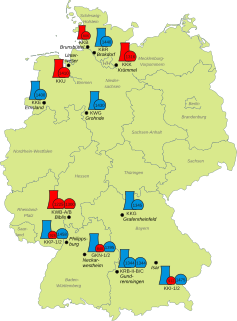
A nuclear power phase-out is the discontinuation of usage of nuclear power for energy production. Often initiated because of concerns about nuclear power, phase-outs usually include shutting down nuclear power plants and looking towards fossil fuels and renewable energy. Three nuclear accidents have influenced the discontinuation of nuclear power: the 1979 Three Mile Island partial nuclear meltdown in the United States, the 1986 Chernobyl disaster in the USSR, and the 2011 Fukushima nuclear disaster in Japan.

The THTR-300 was a thorium cycle high-temperature nuclear reactor rated at 300 MW electric (THTR-300) in Hamm-Uentrop, Germany. It started operating in 1983, synchronized with the grid in 1985, operated at full power in February 1987 and was shut down September 1, 1989. The THTR-300 served as a prototype high-temperature reactor (HTR) to use the TRISO pebble fuel produced by the AVR, an experimental pebble bed operated by VEW. The THTR-300 cost €2.05 billion and was predicted to cost an additional €425 million through December 2009 in decommissioning and other associated costs. The German state of North Rhine Westphalia, Federal Republic of Germany, and Hochtemperatur-Kernkraftwerk GmbH (HKG) financed the THTR-300’s construction.
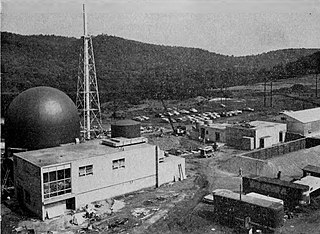
The Saxton Nuclear Experiment Station, also known as the Saxton Nuclear Generating Station or Saxton Nuclear Experimental Corporation Facility, was a small nuclear power plant located in Bedford County, near Saxton, Pennsylvania.

Isar I and Isar II are two base load nuclear power plants which have been built in Germany next to the Isar river. They are fourteen kilometres away from Landshut, between Essenbach and Niederaichbach.

The Nanticoke Generating Station was a coal-fired power station in Nanticoke, Ontario in operation from 1972 to 2013. It was the largest coal power station in North America and, at full capacity, it could provide 3,964 MW of power into the southern Ontario power grid from its base in Nanticoke, Ontario, Canada, and provided as much as 15% of Ontario's electricity.

Nuclear power in Germany accounted for 13.3% of German electricity supply in 2021, generated by six power plants, of which three were switched off at the end of 2021, the other three due to cease operation at the end of 2022 according to the complete nuclear phase-out plan of 2011. However, in early 2022 this plan was called into question once more in light of the 2022 Russian invasion of Ukraine which threatens Germany's supply of natural gas. There have been calls to either delay the shutdown of the remaining three reactors or to restart operation in those reactors that were shut down in late 2021.

Carolinas–Virginia Tube Reactor (CVTR), also known as Parr Nuclear Station, was an experimental pressurized tube heavy water nuclear power reactor at Parr, South Carolina in Fairfield County. It was built and operated by the Carolinas Virginia Nuclear Power Associates. CVTR was a small test reactor, capable of generating 17 megawatts of electricity. It was officially commissioned in December 1963 and left service in January 1967.

Nuclear power in Switzerland is generated by three nuclear power plants, with a total of four operational reactors (see list below). In 2013, they produced 24.8 terawatt-hours (TWh) of electricity, down 5.8% from 2007, when 26.4 TWh were produced. Nuclear power accounted for 36.4% of the nation's gross electricity generation of 68.3 TWh, while 57.9% was produced by hydroelectric plants and 5.7% came from conventional thermal power stations and non-hydro renewable energy sources.

The UNGG is an obsolete nuclear power reactor design developed in France. It was graphite moderated, cooled by carbon dioxide, and fueled with natural uranium metal. The first generation of French nuclear power stations were UNGGs, as was Vandellos unit 1 in Spain. Of ten units built, all were shut down by end 1994, most for economic reasons due to staffing costs.

Brokdorf Nuclear Power Plant is a Power Plant close to the municipality of Brokdorf in Steinburg, Schleswig-Holstein, Germany that shut down on New Year's Eve 2021. It remains capable of restarting operations as decommissioning hasn't started as of March 2022.

The Grafenrheinfeld nuclear power plant is a now-offline electricity-generating facility near Grafenrheinfeld, south of Schweinfurt at the river Main. The plant operated from 1981 to June 28, 2015, when it was taken offline as part of the phase out policy for nuclear power in Germany.
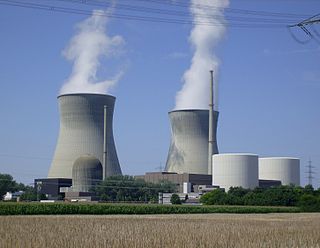
The Gundremmingen Nuclear Power Plant is a nuclear power station in Germany. It is located in Gundremmingen, district of Günzburg, Bavaria. It is operated by Kernkraftwerk Gundremmingen GmbH, a joint operation of RWE Power AG (75%) and PreussenElektra (25%). Unit B was shut down at the end of 2017. Unit C, the last boiling water reactor in Germany, was shut down on New Year's Eve 2021, as part of the German nuclear phase out. However, Gundremmingen unit C as well as the other two German nuclear reactors shut down that day remain capable of restarting operations as of March 2022. In november 1975, Unit A was the site of the first fatal accident in a nuclear power plant and subsequently of a major incident resulting in a total loss in 1977.

The Brennilis Nuclear Power Plant (EL-4) is a decommissioned site located in the Monts d'Arrée in the commune of Brennilis in Finistère, France.
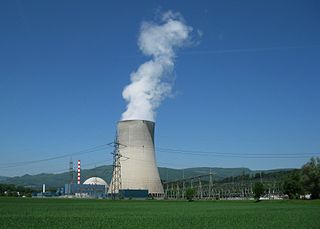
The Gösgen Nuclear Power Plant is located in the Däniken municipality on a loop of the Aar river. It is operated by the ad hoc society Kernkraftwerk Gösgen-Däniken AG.

Obrigheim Nuclear Power Plant (KWO) is a mothballed nuclear power plant in Obrigheim, Neckar-Odenwald-Kreis, on the banks of the Neckar and owned by EnBW. It operated a pressurized water reactor unit from 1969 to 2005. It has been defuelled since 2007, with spent fuel rods awaiting transport to an interim storage facility. In March 2017, EnBW tested the shipment of numerous castors by a barge on the Neckar to Neckarwestheim Nuclear Power Plant.
The EGP-6 is a Russian small nuclear reactor design. It is a scaled down version of the RBMK design. As the RBMK, the EGP-6 uses water for cooling and graphite as a neutron moderator. EGP is a Russian acronym but translated into English stand for Power Heterogenous Loop reactor. It is the world's smallest running commercial nuclear reactor, however smaller reactors are currently in development. The EGP-6 reactors are the only reactors to be built on perma-frost.
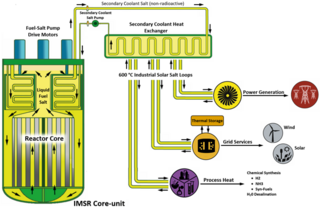
The Integral Molten Salt Reactor (IMSR) is a nuclear power plant design targeted at developing a commercial product for the small modular reactor (SMR) market. It employs molten salt reactor technology which is being developed by the Canadian company Terrestrial Energy. It is based closely on the denatured molten salt reactor (DMSR), a reactor design from Oak Ridge National Laboratory. It also incorporates elements found in the SmAHTR, a later design from the same laboratory. The IMSR belongs to the DMSR class of molten salt reactors (MSR) and hence is a "burner" reactor that employs a liquid fuel rather than a conventional solid fuel; this liquid contains the nuclear fuel and also serves as primary coolant.

Großwelzheim Nuclear Power Plant,, was an experimental nuclear power plant consisting of one 25 MW reactor in Großwelzheim, a district of Karlstein am Main.

























